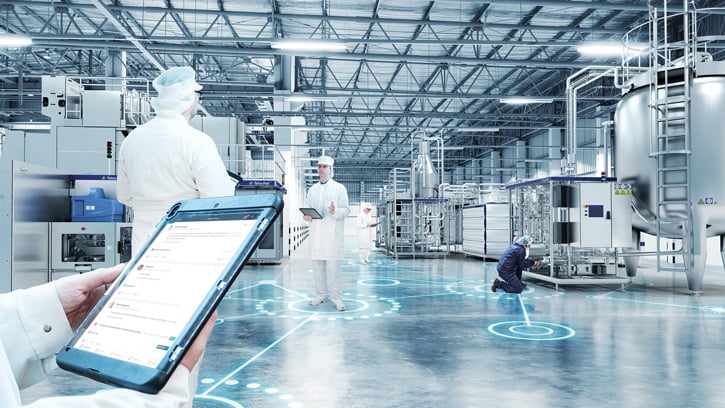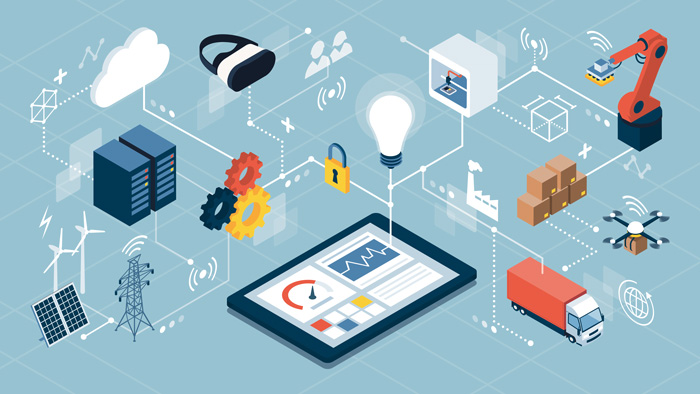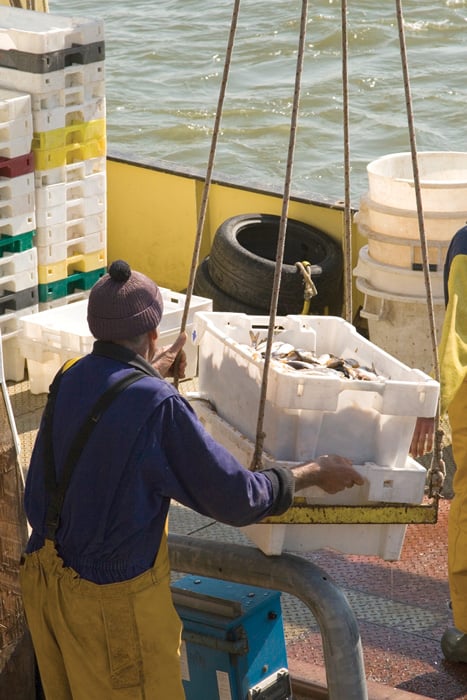Moving Food Processing to Industry 4.0 and Beyond
PROCESSING
The world economy is on the verge of rapid digital transformation, and that includes food processing. The global industrial automation market is predicted to be worth $297 billion by 2026, with food and beverage applications making up 11% of the market. Internet of Things (IoT) technologies, such as sensors, simulations, artificial intelligence–based autonomous systems, additive manufacturing, cloud systems, and blockchain, are projected to have the greatest impact on the food processing industry by enabling integration of physical processes, computation, and networking in cyber-physical systems.
Such digitalization and integration can offer an unprecedented opportunity for business gains. Enabling technologies are under rapid development and their transfer to the food industry will be key. However, it will also be important to create resilient innovation pathways with human-inclusive strategies that take into account human health, consumer preferences, and workforce model shifts.
Industry 4.0 and Society 5.0
Systems of connected sensors, devices, machinery, and data analytics are helping businesses of various sizes improve efficiency, quality, and safety while reducing costs and time to market. This kind of accelerated disruption through digitalization and automation creates the foundation of Industry 4.0.
“The fourth industrial revolution” was first publicized in 2011 by a German manufacturing industry initiative that aimed to improve the competitiveness of the national technological strategy. The now globally adopted term refers to meeting the requirements of businesses and industrial applications while also improving intelligence from cradle to cradle, through a complete integration of technology. As a result, two advances are made possible: greater improvement in the efficiencies among supply chain members as well as at the interface of human and physical systems.
As the food industry slowly transitions to Industry 4.0, the progression into 5.0 is already being conceptualized. This new paradigm, Society 5.0, was first presented by the government of Japan. Unlike Industry 4.0, Society 5.0 is not limited to the manufacturing sector but utilizes technology for solving pervasive societal issues with deliberate inclusion of human elements. Combined with the pressing environmental issues and human components, industries are now at the crossroads to contemplate the future of manufacturing within the upcoming fifth industrial paradigm, which promises the use of technology for more sustainable, resilient, and equitable cyber-physical systems.
Because the food industry involves many human elements and is both the driver and the subject of environmental impacts, adapting to 5.0 will be essential for rapidly changing innovation landscapes, the demands of society, and challenges such as pressure on natural resources, ecosystems, global warming, and population increase. Implementation of a robust innovation plan can begin with identification of the technologies suitable for specific food products and processes and consideration of industrial paradigm shifts for all-inclusive value chains.
Industry 4.0 in Food Processing
Food processing operations have benefitted from Industry 4.0 concepts by improving traceability, monitoring, and control of food quality; improving safety, manufacturing, automation, and training; predicting sensory and consumer preferences; and reducing loss and waste.
For example, Siemens employs several IoT components and digitalization tools for various processes, including brewing, sugar production, dairy processing, baking, and agricultural production. Another example is a multi-sensor system that uses ultraviolet fluorescence imaging and acoustic sensors to assess fouling in chocolate spread production as part of the clean-in-place systems decision-making.
Tetra Pak implements various sensor networks and data analytics tools to improve business productivity, manufacturing sustainability, and human centricity of digital transformation in its own 53 production factories, as well as on its customers’ processing and filling equipment globally. Tetra Pak machines are equipped with sensors that are then combined with the Microsoft Azure IoT Hub and viewed in the Power BI data visualization platform to improve performance and drive continuous improvement activities within the Total Predictive Maintenance framework. Routine action alerts based on the real-time data and models obtained from manufacturing assets are monitored by a global Quality and Performance Management Center, and automatically sent to field-based staff and consumer maintenance personnel as part of the predictive maintenance services.
“Major success stories are from automated data analytics, AI-based product improvements, and cloud-based training and human-machine collaboration apps. We were able to predict specific equipment issues and downtimes with a near 100% success rate,” says Sasha Ilyukhin, vice president of Tetra Pak Services and Industry 4.0 Solutions, “enabling us to replace fixed maintenance intervals partially with data-based predictions obtained from sensors measuring temperature and vibration profiles.”
In another case study from a U.S.-based cheese manufacturer, machine learning correlation models were trained with six months of historical data on 29 different processing variables, including the amount of starter culture, mixing times, and raw milk composition, to classify impacts on the final moisture content. As a result of the optimization study, the manufacturer was able to reliably increase average moisture content by up to 0.6% within regulatory compliance limits, corresponding to more than $1 million in savings in one year.
“All-inclusive digitalization is a never-ending journey,” Ilyukhin adds. He advises food processors to adopt a robust digitalization scale-up plan with a business strategy on the type and the platform of data collection, architecture, analysis, security, and technology ownership.
AI Applications
Artificial intelligence (AI) can enable further optimization, automation, and rapid decision-making through object recognition and computer vision without necessarily shedding light on the underlying complex physical mechanisms. Even though the jury is still out on the pros and cons of black-box models over mechanistic or combination approaches, AI can permit rapid and real-time decision-making by replacing mundane or challenging tasks in processing operations.
One challenging task for food businesses is predicting consumer tastes. Gastrograph AI by Analytical Flavor Systems tackles this challenge with genetic algorithms in artificial intelligence based on reviews from different consumer demographics, broken down by characteristics like age, geographic location, and gender. The Gastrograph process creates a sensory baseline for various consumer groups and can predict the impact of formulation changes on targeted groups from early concept to flavor houses. The analytics provide specific flavor profile insights for product developers, saving a significant amount of time and cost.
Food safety as an essential component in food processing will also be an important topic of AI-based models. KanKan by Remark Holdings developed an AI solution equipped with face- and object-recognition technology to track operator movement and food safety compliance practices.
In another successful application of machine learning, Murphy et al. (2021) used bacterial spoilage indicator data from 23 dairy processing facilities to identify post-pasteurization contamination factors. That study highlighted the sensitivity of minimizing contamination through good manufacturing processes, equipment differences, and in-house final product inspections. The study also revealed the viability of AI approaches using unstructured and correlated data for analysis and processing management.
Cleaning costs, water, and downtime were cut by monitoring residue levels and optimizing cleaning schedules using real-time ultrasonic sensors and imaging data assessed by AI algorithms. This concept of self-optimizing clean-in-place was developed by a team from Martec of Whitwell with support from the University of Nottingham and the Centre for Sustainable Manufacturing and Recycling Technologies at Loughborough University.
Challenges and Potential
Despite the success stories and the opportunities, digitalization in the food industry has been slow. Challenges may be due to the incompatibility of equipment from various vendors, digitalization costs, old equipment that cannot be manually retrofitted, and lack of expertise, among other factors. Selection of the right IoT system involves considerations such as operating costs, power, internet connectivity, data analysis, the number of connected devices, and more. In a 2017 survey, food suppliers from different countries reported vulnerability against potential attacks in IoT infrastructure (21%), data privacy concerns (18%), inability to analyze generated data (16%), the lack of standards for IoT arrangements (15%), and regulatory reporting changes driven by the technology (13%) as the prominent reasons for not adopting new technologies and processes (Rentokil 2017).
Additionally, data-driven models require a vast amount of data training and validation. The data requirements for machine learning and AI models involve consideration for multiscale, multimodal, openness, and standardization, which will require trained professionals who understand food industry dynamics as well as the technological advancements.
Higher education in food science can play a role in moving the industry from 4.0 to 5.0 by focusing on workforce development for the new industrial era. This will require collaboration among food science and engineering departments supported by the food industry. Companies can benefit from the computational power and domain capabilities of universities with access to state-of-the-art methods.
The Human Element
While food and beverage businesses are late to transition to Industry 4.0, the human component central to Industry 5.0 is also missing or poorly integrated. Exclusion of the human factor in digitalization efforts can have negative consequences for employees, businesses, and society (Neumann et al. 2021).
Some companies are already experimenting with technologies that support both business processes and human needs. For example, Eachmile Technologies, a supply chain technology company, has developed integrated application concepts mFish, Intelligent Edge, and Fishrr for the seafood industry to track and control relevant product, fishing/farming, and processing data, as well as social and environmental data that demonstrate compliance to regulations and standards. The company, through its Fishcoin project, is using blockchain and incentives to collect and share data via manual data entry or machine-to-machine data acquisition through the connection of IoT sensors in and around farms and on assets such as fishing nets and vessels. Stakeholders downstream can reward those upstream, including fishermen, with digital tokens in exchange for data such as Key Data Elements for traceability or provenance data for storytelling. Digital tokens can be exchanged for mobile data top ups, or even represent ownership in the business of traceability.
“Eachmile aims for decentralized and multisectoral platforms for a value-added transformation of the seafood industry,” says co-founder Alistair Douglas. “Our technology enables rewarding of the first mile members of the value chain, including fishermen and farmers who otherwise do not see a return on investment into traceability systems.
“It is not just about the incentives but also the possible disincentives of data sharing that need consideration, as well the need to consider contingencies from digitalization and subsequent elimination [of] mundane tasks from the daily operations of farming and fishing that is a source of income for people,” Douglas continues. “Engagement of the members with knowledge distribution or tailored learning schemes will be necessary.”
But significant shifts in operational cultures are yet to be seen. Due to this challenge, a more human-centered approach under the next paradigm, Industry 5.0, is at risk, but involving stakeholders across sectors in a collaborative environment while keeping a competitive edge in the playing field holds promise. In addition to machine-centric tools in Industry 4.0, human-centric and AI-enabled tools can create a more balanced structure of human-machine interfaces.
This vast store of experience captured in datasets will increase in power as more data is accumulated and made available and as machine learning and artificial intelligence mine and pinpoint relevant information and solutions.
Collaborative teaming of humans and smart robots will decrease mental and physical stress on workers, reduce manufacturing costs, increase product quality, and enable quick responses to changing customer demands. Advanced robotic systems that are flexible and perform multiple tasks will reduce capital investment and increase manufacturing agility by eliminating the need for several special-purpose tools. Robot-based production systems can also enable efficient batch-of-one production for mass customization.
The good news is, changes spurred by the pandemic may bring about movements toward Industry 4.0 and Industry 5.0 more quickly than originally anticipated.
“The COVID-19 pandemic has accelerated the automation, collaboration, and adaptation,” says Laurette Dubé, chair and scientific director of the McGill Centre for the Convergence of Health and Economics. “It also highlighted the importance of innovations developed with the human-centered economy, health, and environment nexus within the concept of convergent science and innovation.”
And, she says, the door is open to thinking about powerful changes that will benefit society as a whole. “Now is the optimal time to rethink the current hypercompetitive economic model and build a more resilient convergence economy where the industry can tackle significant environmental, societal, and economic challenges through technological implementation in modular structures aligned with the concept of Society 5.0.”
REFERENCES
Murphy, S. I., et al. 2021. “Machine learning and advanced statistical modeling can identify key
quality management practices that affect post-pasteurization contamination of fluid milk.” J. Food Prot.
Neumann, W. P., et al. “Industry 4.0 and the human factor – A systems framework and analysis methodology for successful development.” Intl. J. of Production Economics 233: 107992.
Rentokil. 2017. “The impact of the Internet of Things: From farm to fork.” https://info.rentokil.com/glo/iot-report.
Simeone, A., et al. 2016. “A Multi-sensor Approach for Fouling Level Assessment in Clean-in-Place Processes.” Procedia CIRP 55: 134–139.
Statista. 2017. “Food suppliers issues for Internet of things (IoT) deployment in selected countries as of 2016.” https://www.statista.com/statistics/751651/food-suppliers-issues-for-iot-deployment.
Statista. 2020. “Industrial automation worldwide.” https://www.statista.com/study/87398/industrial-automation-worldwide.
Vaidya, S., P. Ambad, and S. Bhosle. 2018. “Industry 4.0 – A Glimpse.” Procedia Manufacturing 20: 233–238. https://doi.org/10.1016/j.promfg.2018.02.034.






